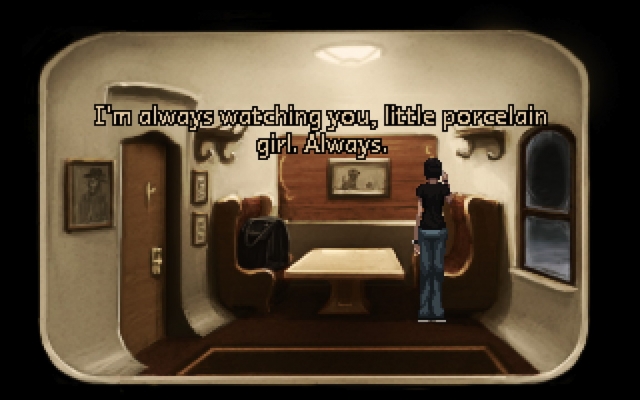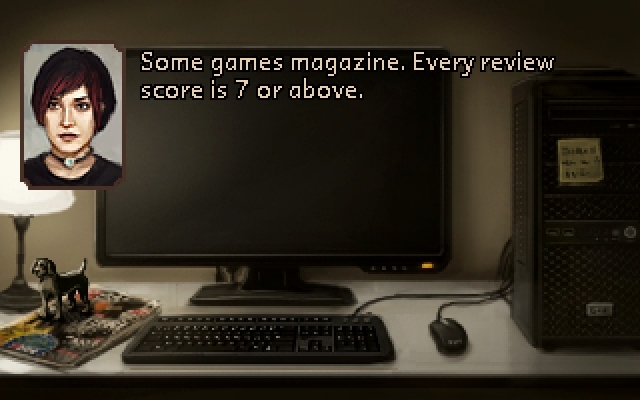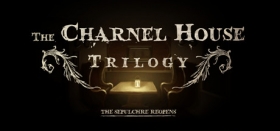
The Charnel House Review
“Can we hurry up and finish this game soon so I can go get a therapist?” I don’t usually play videogames in company, but my girlfriend’s remarks while playing this game with me were quite on point. It’s likely that you will get tired of this game, but its eeriness is undeniable, as badly delivered as it may be. I understand the appeal The Charnel House may have to a new player: indie-like pixeled graphics with a dark and depressive tonal theme, a narrative-focused game with some of the industry’s finest critics as voice-over cast, a clear existentialist undertone behind a death-inspiring title… It sounds like the epitome of alt, doesn’t it? This game does deliver what it promises, but its execution is rather absurd and incoherent.
The Charnel House is side-scrolling graphic adventure, purely led by the narrative context rather than the mechanics. Tired of games that challenge your intellect? No worries mate, The Charnel House will do everything for you. Let me illustrate: did you just find a quote written on a piece of paper? Might it be from a book? A movie? What could it mean? Oh the excitement of puzzle-solving! Oh wait; the game just gave me the answer, literally. Our character explains that it’s a hint to find out the PC’s password, hidden in a book in the bookshelf. So I go check the bookshelf and after checking the few books available, our character remembers the password. As you can see, puzzles can hardly be considered puzzles. The Charnel House isn’t the king of subtlety when it comes to them, so it becomes a matter of following the instructions to reach the solution. In this sense the game reminds me of a precooked meal, where you just microwave the food tray and voila! A depressing Tuesday night dinner for one in front of the TV!
The Charnel House doesn’t require you to think much to progress in the story, or to have any skill with the mouse and keyboard, or to pay much attention, for that matter. The story is linear and there’s no choice to make at any point, so that leaves any need for discern out of the picture. But hey! Some games are just like this! Dear Esther, for example, is quite loved by many, and it is not precisely interactive. Mechanics are not necessarily what makes a videogame good, I can give you that. Although an interactive medium, there are many elements that can be salvaged from this sort of games: visual aesthetics, narrative, soundtrack, etc. Well, can they be salvaged here?
 As I’ve mentioned, The Charnel House puts great emphasis on story, particularly on character development. This is going to be painful to talk about, but here we go. The game is divided in three segments: Inhale and Exhale, the first and last, are about Alex Davenport, a young girl from New York. As far as we know, she is clearly not over her ex; she likes videogames, her couch and swearing. She likes swearing a lot. The middle part of the game, titled Sepulchre and released as a free game in 2013, is about Harold Lang, an overly stereotypical British archaeologist. Their stories intertwined on board of a weird-ass train destined to the fantastic island of Augur Peak.
As I’ve mentioned, The Charnel House puts great emphasis on story, particularly on character development. This is going to be painful to talk about, but here we go. The game is divided in three segments: Inhale and Exhale, the first and last, are about Alex Davenport, a young girl from New York. As far as we know, she is clearly not over her ex; she likes videogames, her couch and swearing. She likes swearing a lot. The middle part of the game, titled Sepulchre and released as a free game in 2013, is about Harold Lang, an overly stereotypical British archaeologist. Their stories intertwined on board of a weird-ass train destined to the fantastic island of Augur Peak.
If you’ve read any of Stephen King’s most esoteric and suggestive books, or if you’re acquainted with Lovecraft’s imagery, you’ll find this game very familiar. I’ll render unto Caesar what is Caesar’s: this game will disturb the crap out of you at some points, but unlike any of these authors, the suggestibility of the imagery is far from subtle or psychological. My main criticism here is about how little this suggestibility and the overall tone fit with the script and character’s mood, particularly in the first and last chapters. Alex is funny, hearty and laid-back; many of her comments about the environment are laughable and innocent, and even more given her playful American accent. Her parts, particularly in the conversations with friends and family, feel more like a commentary on American youth rather than a suggestive horror story. This makes the game’s theme quite at odds with the character’s attitude, and the player never really sinks in one or the other. Admittedly, Harold’s chapter has a more depressing and languid tone, and it’s much less overt in its topics, but given the duration of each chapter (half an hour, ish), I personally didn’t have enough time to snap from one tone to another and back. This meant that by the time I was playing as Harold, a depressive and reluctant middle-aged man, I was still thinking like the youthful and witty Alex, which didn’t fit either with the game’s thematic undertone.
To my surprise, Alex was quite a believable and relatable character; she’s strong but emotional, impulsive and stubborn. Although a diminishing trend, female characters in videogames are not exactly famous for being well constructed, particularly when they’re intended to be deep and complex, so it’s relieving to find some hope for female character-building. The main problem with controlling Alex is that we don’t really have her personal background to relate to any of her friends or family that she’s known for years, particularly when you have less than five-minute conversations with each in the game, and for some reason they end up carrying some weight in the plot. Harold has less time on screen, so his persona is not very deeply explored. It’s easy to draw parallels between the second and third chapter, which also takes over to their personalities and approaches to the horrific events that occur on the train. The contrast between Harold and Alex’s attitude—how he gives up opposed to how she decides to address and face the incidents head-on—does leave room for an interesting analogy, but since the events are repeated, they tend to lose efficacy.
 Again, the game is really creepy at times. It deals with the subconscious and distortion of reality, which is certainly quite ambitious. However, as you may have noticed, I can’t take this game seriously, mainly because the way it presents these topics is nothing but confusing. The game plays with its geographical location, alternating British and American accents and currencies, which makes it even more confusing given that the train departed from New York. Characters deny having conversations you definitely had with them for no apparent reason, and their attitude towards you shifts from indifferent, to friendly, to hostile, with no clear cause to such changes. It’s probable that the intention of these inconsistencies is indeed to unsettle the player, but it ends up being a cheap tactic that will leave you disoriented and diverted rather than pensive. Instead of being a boost to the suggestive atmosphere, it is just distracting and feels incoherent and unnecessary. My girlfriend’s “what the fuck?” usual comment at these points—normally while laughing—is quite illustrative of how little effective they are.
Again, the game is really creepy at times. It deals with the subconscious and distortion of reality, which is certainly quite ambitious. However, as you may have noticed, I can’t take this game seriously, mainly because the way it presents these topics is nothing but confusing. The game plays with its geographical location, alternating British and American accents and currencies, which makes it even more confusing given that the train departed from New York. Characters deny having conversations you definitely had with them for no apparent reason, and their attitude towards you shifts from indifferent, to friendly, to hostile, with no clear cause to such changes. It’s probable that the intention of these inconsistencies is indeed to unsettle the player, but it ends up being a cheap tactic that will leave you disoriented and diverted rather than pensive. Instead of being a boost to the suggestive atmosphere, it is just distracting and feels incoherent and unnecessary. My girlfriend’s “what the fuck?” usual comment at these points—normally while laughing—is quite illustrative of how little effective they are.
Another problem with the perturbing imagery is its lack of subtlety and thus, suggestibility. For those who’ve played Silent Hill 2—which should be everybody by now, because that game is amazing—, you may recall all the references to sexuality hidden in the enemies’ design. They were disturbing, but the game didn’t need to rub it on your face by explicitly telling you about them, or about any gore and morbid scenario. It was you and your little head that subconsciously made the connections out of the understated information, and the result was a lingering sense of implicit perturbation towards the events. The Charnel House is very different from Silent Hill 2: it explicitly lets you know which parts are messed up—frequently by a statement from a character—, which are often very morbid descriptions of scenes you’d find in Dead Space or Saw. I wouldn’t say that’s exactly subtle. Horrifying, maybe, but not subtle, which makes them feel quite artificial. What’s more, usually there’s no build-up for any of these moments, so some will even make you giggle out of how out of the blue they come across. This, again, is due to the lack of consistency between theme and tone.
As soon as you start the game, you will find that the dialogues are littered with references to videogames and videogame journalism, from BioShock to commentaries about review scores and videogame tropes. They only appear for about the first half of the game, and they’re again rubbed on your face. It’s as if the game smirked at you saying “Did you see what I did there?” At some point, Harold says “please don’t tell me he’s going to make me solve one ridiculous conundrum of his…” obviously referring to some videogame design devices. I still can’t take this seriously; they feel shoehorned, pasted in, and very inconsistent, since they don’t show up anymore for the second half. Moreover, by being so unsubtly sarcastic, they don’t fit at all with the lugubrious overall tone of the game.
 Probably the reason why the designers felt that these references had to be included is because of who they are. Ashton Raze, the author, used to write reviews for Gamespot; Peter Willington, voice-acting Harold, is a writer for Pocket Gamer; and then there’s Jim Sterling, from The Escapist and Destructoid. Sterling gives voice to a guy called Rob, whose every interaction felt in need of closing up with “and thank God for me”. As soon as you start playing you realise that these people are not voice actors. The delivery of their lines feels forced and artificial, at the same time that the questionable script tries to keep it natural and colloquial. Particularly in the case of Sterling, it’s impossible to disconnect the voice and the actor, which doesn’t do a lot for immersion. Except from Alex, who’s voice-acted by writer Madeleine Roux and the only one that can be considered decent acting, every character’s voice is unnatural and plastic, some being occasionally unintelligible.
Probably the reason why the designers felt that these references had to be included is because of who they are. Ashton Raze, the author, used to write reviews for Gamespot; Peter Willington, voice-acting Harold, is a writer for Pocket Gamer; and then there’s Jim Sterling, from The Escapist and Destructoid. Sterling gives voice to a guy called Rob, whose every interaction felt in need of closing up with “and thank God for me”. As soon as you start playing you realise that these people are not voice actors. The delivery of their lines feels forced and artificial, at the same time that the questionable script tries to keep it natural and colloquial. Particularly in the case of Sterling, it’s impossible to disconnect the voice and the actor, which doesn’t do a lot for immersion. Except from Alex, who’s voice-acted by writer Madeleine Roux and the only one that can be considered decent acting, every character’s voice is unnatural and plastic, some being occasionally unintelligible.
Lastly, I must say that I found the visual style rather appealing; it happens to be the only thing that fits with the game’s theme. This low-res pixelated graphic style, however, does not allow for much detail in the environment. This forces the characters to state their findings in an overly descriptive manner. Once more, the lack of subtlety in the dialogues is perseverant. For instance, Alex tends to find unopened parcels lying around the house, but you never see them; she talks about what they are and then she puts them back where they were right after. I’m still struggling to make sense of why they were even included in the game. Most conversations are very obvious, explicit and utterly unsubtle; the only depth to the game’s conversations was Alex’s attitude towards her ex, but it becomes weird and confusing once on the train. Continuing with my food comparisons, dialogue in this game is like the kids menu of a mid-quality restaurant: there’s nothing exquisite about them; it’s usually simple and shallow, like chicken nuggets with ketchup. Not exactly a quality meal.
All in all, the game is nothing short of confusing and disappointing. The ending leaves too many mysteries unresolved, and it’s not suggestive enough to lead the player into a solid conclusion. I’m still hesitating about whether any of the events were real or not, which is not necessarily bad, but I have the impression that the devs don’t know it either. However, the game sometimes does have atmosphere, but it’s likely to be ruined by its inconsistencies, the music that feels often oddly out of place, or the badly-written performance of the actors. Here is proof that game journalism and design are not as related as you may think, and that dark and mysterious share a thin line with confusing and absurd.
The Charnel House Trilogy (Reviewed on Windows)
Minor enjoyable interactions, but on the whole is underwhelming.
Inconsistent, confusing, with tedious conversations and over-hyped by the voice-acting cast, The Charnel House is quite a disappointment. Although it will creep you out, the trick to do so feel cheap and shallow.










COMMENTS